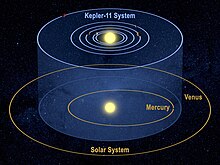开普勒11
| 观测资料 历元 J2000 | |
|---|---|
| 星座 | 天鹅座 |
| 星官 | |
| 赤经 | 19h 48m 27.622s[1] |
| 赤纬 | +41° 54′ 32.87″[1] |
| 视星等(V) | 14.2[2] |
| 天体测定 | |
| 自行 (μ) | 赤经:–0.7[1] mas/yr 赤纬:–4.1[1] mas/yr |
| 距离 | 613[2] pc |
| 特性 | |
| 光谱分类 | G6V[3] |
| 详细资料 | |
| 质量 | 0.95 (± 0.1)[4] M☉ |
| 半径 | 1.1 (± 0.1)[4] R☉ |
| 表面重力 (log g) | 4.47[5] |
| 温度 | 5680 (± 100)[4] K |
| 金属量 [Fe/H] | 0 (± 0.1)[4] dex |
| 年龄 | 8 (± 2)[4] Gyr |
| 其他命名 | |
开普勒11(英语:Kepler-11)是一颗类似太阳的恒星,位于天鹅座内,距离地球约2,000光年。[3][6]这颗星是由开普勒太空望远镜发现,并由美国航空航天局于2011年2月2日公布。开普勒11是首个被确定拥有6颗行星的恒星。所有开普勒11的行星质量均介于地球与海王星之间。[7]
命名和历史
[编辑]于2011年2月2日,美国航空航天局宣布至少有六颗公转周期很短的太阳系外行星围绕这颗恒星运转。开普勒11是以发现这颗恒星的开普勒太空望远镜命名的。这颗恒星是开普勒太空望远镜发现的第11颗恒星,因此得名“开普勒11”。[3]
这颗恒星位于天鹅座,距离地球约2000光年。这颗恒星是由开普勒太空望远镜的小范围巡天发现的。从地球的方向观察开普勒11的6颗行星会发现所有行星在凌日时会从恒星盘面通过;且这些行星位置和地球上观测者观测方向的夹角小于1度。这种状况使科学家们可以经由观测行星凌日现象直接量测行星的公转周期和直径。[8] 电脑模拟显示这个行星系统内各行星之间轨道夹角大约为1°,这代表该行星系统比我们的太阳系(夹角约 2.3°)更接近共面状态[3]。开普勒11是第一个被发现的同时有多于3颗行星凌日的系外行星系统。这些行星从内到外以字母顺序分别命名为b、c、d、e、f和g。[9]

性质
[编辑]开普勒11是一颗G型主序星,而其恒星光谱分类则为G6V。其质量约为太阳质量的95%,半径约为太阳半径的110%。其表面温度约为5680 ± 100 K,比太阳的表面温度(5,778 K)稍低。[10]其年龄约为80 ± 20 亿年[4],比太阳的年龄(45.7亿年)高近一倍。[11]
这颗星的视星等为14.2,而地球上人类以肉眼能够分辨的最暗天体极限的视星等为6.5,因此人类是无法看见开普勒11的。[4]
行星系统
[编辑]
从地球观看开普勒11行星系时,所有开普勒11的行星都会凌开普勒11,而且开普勒11各行星的轨道倾角在地球视野上的偏差仅为1°,因此天文学家们能够透过凌日法发现这些行星。天文学家们制作的开普勒11行星系模型显示,开普勒11各行星的平均轨道倾角为1°,代表开普勒11行星系要比平均轨道倾角为2.3°的太阳系还要接近共面。[3]
行星b到行星f的估算质量介于地球与海王星之间。这些行星的估算密度都较低,说明这五颗行星中都不具有像地球一样的成分组成。[7]a 行星d和行星e(可能还包括行星f)都拥有主要成分为氢气的大气,而行星b和行星c则可能由大量的冰和/或氢气/氦气组成。[3]这些行星密度较低的解释可能为:这些行星都是以较小的岩石或铁为核心,围绕着大体积大气层的气体行星。[12]其内行星在其发现之时,是人类了解最全面,且规模小于海王星的系外行星。[13]
开普勒11行星系统是目前已知的最紧凑的行星系统;行星b至f的轨道在水星的轨道范围内,而行星g的半长径比则比水星大约20%。尽管轨道结合的十分紧密,其整体动力状态一般认为已稳定存在数十亿年[3]。
虽然行星b和c的公转周期接近于5:4的共振[3],但这些行星中不存在低比率的轨道共振。尽管这些行星之间的距离甚近,但仍然没有影响对方的轨道,而这个情况已持续了数十亿年。[12]
| 行星 | 质量 (ME) |
半径 (RE) |
密度 (g/cm3) |
轨道周期 (d) |
半长径 (AU) |
离心率 | 轨道倾角 (°) |
发现年份 | |
|---|---|---|---|---|---|---|---|---|---|
| b | 4.3 (2.3 - 6.5) | 1.97 ± 0.19 | 3.1 (1.6 - 5.2) | 10.30375 | 0.091 | 0 | 88.5 | 2011[4] | |
| c | 13.5 (7.4 - 18.3) | 3.15 ± 0.30 | 2.3 (1.2 - 3.6) | 13.02502 | 0.106 | 0 | 89 | 2011[4] | |
| d | 6.1 (4.4 - 9.2) | 3.43 ± 0.32 | 0.9 (0.6 - 1.4) | 22.68719 | 0.159 | 0 | 89.3 | 2011[4] | |
| e | 8.4 (6.5 - 10.9) | 4.52 ± 0.43 | 0.5 (0.3 - 0.7) | 31.9959 | 0.194 | 0 | 88.8 | 2011[4] | |
| f | 2.3 (1.1 - 4.5) | 2.61 ± 0.25 | 0.7 (0.3 - 1.4) | 46.68876 | 0.25 | 0 | 89.4 | 2011[4] | |
| g | < 300 (0.95 MJ) | 3.66 ± 0.35 | 118.37774 | 0.462 | 0 | 89.8 | 2011[4] | ||
 开普勒11的6颗行星相对体积与位置 (黄色圆圈 a 是母星,直径以实际比例绘制;行星的直径则比实际比例放大50倍) | |||||||||
 与内太阳系的对比,行星的直径则比实际比例放大50倍。 | |||||||||
参见
[编辑]参考资料
[编辑]- ^ 1.0 1.1 1.2 1.3 Zacharias, N.; et al, The Third US Naval Observatory CCD Astrograph Catalog (UCAC3), The Astronomical Journal, June 2010, 139 (6): 2184–2199, Bibcode:2010AJ....139.2184Z, arXiv:1003.2136
 , doi:10.1088/0004-6256/139/6/2184.
, doi:10.1088/0004-6256/139/6/2184.
- ^ 2.0 2.1 2.2 Kepler Discoveries. NASA Ames Research Center. [4 February 2011]. (原始内容存档于2016-05-11).
- ^ 3.0 3.1 3.2 3.3 3.4 3.5 3.6 3.7 Lissauer, J. J.; et al.. A closely packed system of low-mass, low-density planets transiting Kepler-11 (PDF). Nature. 3 February 2011, 470 (7332): 53–58 [4 February 2011]. Bibcode:2011Natur.470...53L. arXiv:1102.0291
 . doi:10.1038/nature09760. (原始内容存档 (PDF)于2015-11-07).
. doi:10.1038/nature09760. (原始内容存档 (PDF)于2015-11-07).
- ^ 4.00 4.01 4.02 4.03 4.04 4.05 4.06 4.07 4.08 4.09 4.10 4.11 4.12 Star : Kepler-11. Extrasolar Planets Encyclopaedia. [2011-02-02]. (原始内容存档于2011-02-07).
- ^ Borucki, W. J.; et al, Characteristics of planetary candidates observed by Kepler, II: Analysis of the first four months of data, The Astrophysical Journal, 2011, 736: 19, Bibcode:2011ApJ...736...19B, arXiv:1102.0541
 , doi:10.1088/0004-637X/736/1/19
, doi:10.1088/0004-637X/736/1/19
- ^ Astronomers Find 6-Pack of Planets in Alien Solar System. [2014-01-06]. (原始内容存档于2019-05-29).
- ^ 7.0 7.1 博伊尔, 艾伦. Planetary six-pack poses a puzzle. MSNBC Cosmic Log. msnbc.com. 2011-02-02 [2011-02-02]. (原始内容存档于2011-02-04).
- ^ Michael Mewhinney; Rachel Hoover; Trent J. Perrotto. NASA's Kepler Spacecraft Discovers Extraordinary New Planetary System. NASA. 2 February 2011 [4 February 2011]. (原始内容存档于2020-02-01).
- ^ Nasa Report. [2011-02-04]. (原始内容存档于2020-02-01).
- ^ Fraser Cain. Temperature of the Sun. Universe Today. September 15, 2008 [19 February 2011]. (原始内容存档于2010-08-29).
- ^ Fraser Cain. How Old is the Sun?. Universe Today. 16 September 2008 [19 February 2011]. (原始内容存档于2010-08-18).
- ^ 12.0 12.1 Naeye, Robert. Kepler's Outrageous System of Six Planetsv. SkyandTelescope.Com. 天空与望远镜杂志. 2011-02-02 [2011-02-03]. (原始内容存档于2014-01-06). 外部链接存在于
|work=(帮助) - ^ John Matson. A Wealth of Worlds: Kepler Spacecraft Finds 6 New Exoplanets and Hints at 1,200 More. Scientific American. 2 February 2011 [20 February 2011]. (原始内容存档于2013-10-30).
外部链接
[编辑]- Official release: NASA's Kepler Spacecraft Discovers Extraordinary New Planetary System(页面存档备份,存于互联网档案馆)
- YouTube: Animation of Kepler-11 planetary system(页面存档备份,存于互联网档案馆)
- Kepler 11 Planetary System with Orbits and Planet Sizes(页面存档备份,存于互联网档案馆)
| |||||||||||||||||||||||||||||||||||||||||||||||||||||||||||||||||||||||||||||||||||||||||||||||||||||||||
Text is available under the CC BY-SA 4.0 license; additional terms may apply.
Images, videos and audio are available under their respective licenses.

